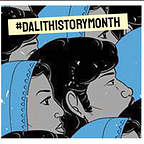Godna Painting: A Dalit Women’s Art of Resistance
by Megha Malakar
Mainstream art and culture have been dominated and dictated by “upper”-caste and “upper”-class communities. Not only do they have a popular support base for their art but also have a huge play in the market where their paintings are sold, making the already rich communities even richer. For example, Madhubani and Mithila artforms are popular Indian mainstream artforms that are the face of Indian culture and pride.
However, there exists alternate art forms by marginalised communities that seldom come to limelight. In this article one such art form, called Godna painting, is explored.
Godna paintings are created by Dalit women who face the triple discrimination of caste, gender and poverty and hence they are never given their due recognition. The existence of Dalit women is marked by discrimination, oppression and subjugation by other castes as well as from men from their own caste. Creating and popularising an art form is therefore a symbol of resistance, protest and hope for a better future where Dalit women can thrive to be independent and self-reliant.
In 1970, German anthropologist, Erika Moser entered a Dusadh Dalit community the village of Jitwarpur in Bihar and suggested that the Dalit women there start art and painting, pursuits that might allow them to gain some economic independence. In this Mithila region, art by Brahmin and Kayastha women was already popular back then and their form was the quintessential Mithila Painting.
It was only after this meeting with Moser in 1970 that a new form of art called Godna or tattoo painting came about and for the very first-time popularised this Dalit artform. While Mithila and other forms of “upper”-caste paintings often took on the subjects of God and depicted scriptural scenes, Dalits as “untouchables” were barred from practicing these devotional or divine art forms. So these women took inspiration from nature than God for their art. They drew plants, animals, birds, and rivers — things that one can find around them. The natural world that they interacted with on a daily basis.
Godna paintings has exited for several generations as tattooing art forms in these communities. Dalit women inked and wore similar forms of tattoos on their body. That too was a tradition that rose out of their caste status. Dalits were not allowed to decorate themselves with jewellery. These were reserved for the “upper”-castes. So Dalit women decorated themselves with tattoos.
After meeting Moser, the women turned their tattoos onto other canvases and expanded their artistic ideas. They even began using materials like cow dung to create canvases on which they would paint. In contrast to “upper”-caste traditions, Dalits also use brighter colours and the sources of these colours are usually natural - turmeric, colour from flowers, leaves, bark and other carbonaceous materials. These approaches enrich Godna art and give it it’s unique artistic aesthetic.
Godna painting is still a less well-known art. Dalit artisans practicing this art form are still struggling to get a decent income in markets. The art and its history has not yet received the appreciation and recognition that it should.
Despite this, people continue to paint in the Godna style because there is a deep aspect of resistance to this art. The artform of tattoo painting by Dalit women not only became a form of expression of subaltern art but also a symbol of annihilation of caste and oppression. In the past, tattoos were forced on Dalit women as markers or symbols of identification of caste but the same tattoos turned into symbols of resistance and pride for the whole community. They have now successfully created a space for themselves to express and resist using art. The potential of Godna art extends to annihilation of caste as well as creating a different space for the marginalised to restore their self-dignity and pride.
Megha Malakar identifies as a Dalit queer woman and is currently pursuing her Master’s Degree in Social Work from Tata Institute of Social Sciences (TISS), Mumbai, India. Her aim is to utilise platforms to amplify the voices of her community. Meghna enjoys writing, watching Japanese anime, as well as travelling and experiencing different places and cultures.
